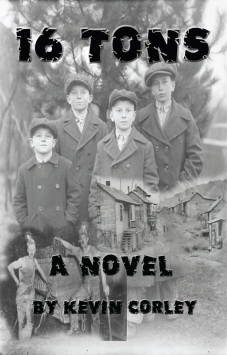Book Review: Sixteen Tons

Sixteen Tons by Kevin Corley, Hard Ball Press, 2014.
Mother Jones once proclaimed Illinois to be “the best-organized labor state in America,” and the people of the Illinois coalfields—where Kevin Corley’s enjoyable new novel Sixteen Tons takes place—were always at the center of the action.
At the beginning of the nationwide coal strike of 1897, only 400 Illinois miners were members of the United Mine Workers of America. By the strike’s conclusion, the number stood at 30,000.
The following year owners of the Chicago-Virden Coal Company brought in non-union miners from out of state. The effort to land them prompted a confrontation known in popular local history as the “Virden Mine Riot.” A number of security guards and striking miners were shot dead, and many more were injured.
But the non-union miners never got off the train, and the gains made by the 1897 strike (higher wages, union recognition) were solidified. At her request, Mother Jones was later buried in the only union-owned cemetery in America, with the striking miners who died at Virden.
Illinois miners later grew dissatisfied with what they saw as the autocratic rule of United Mine Workers President John L. Lewis. They and their families formed the breakaway union Progressive Miners of America in 1932 to get grassroots control over union decision-making.
An Ordinary Family
Sixteen Tons is grounded in this historical context. Beginning in the aftermath of the 1897 strike, the book traces several decades of trying times for the Vacca family, Italian immigrants to Illinois.
Family patriarch Antonio leaves the non-union West Virginia mining fields for the higher standard of living of union miners in Illinois. He soon marries Angeline, and the couple raises four sons.
Characters from this next generation are placed at several key labor history moments over the next several decades. Through World War I, the influenza pandemic, and leading up to the Great Depression, the Illinois split with John L. Lewis, and the formation of the PMA, Corley weaves a satisfying narrative. His characters go through trying times, disasters, and small triumphs.
During the “Illinois Coal Mine Wars” of the 1930s, miners fought among themselves as they struggled to weather difficult times. The Vacca family itself is divided. Antonio’s sons come to different conclusions as to where to place their loyalties.

SUPPORT LABOR NOTES
BECOME A MONTHLY DONOR
Give $10 a month or more and get our "Fight the Boss, Build the Union" T-shirt.
A strong and militant Women’s Auxiliary characterized the early PMA and its first auxiliary president, Agnes Burns Wieck. Strong women characters also add to the book, as does Corley’s handling of immigration and race.
Antonio witnesses the segregation of African American miners during an organizing campaign in the South. Unionization in the early twentieth century at times served as a uniting force between ethnicities and races. But the era’s brutal realities, sometimes carried out by white union miners, are not washed over in Corley’s work. For example, Virden tried to use African-American strikebreakers.
Everyday Life
Corley has not only spent years teaching in Illinois classrooms—he has also interviewed participants in the Mine Wars.
It shows. Sixteen Tons is at its best when describing work, culture, leisure, and everyday life in close-knit Illinois mining communities. Readers get a window into these worlds: the importance of ethnic cooking, church, child-raising, Italian wine, conversations in speakeasies. Corley details the nuances and craftsmanship of actual coal extraction, before the era of large-scale mechanization.
Corley stays true to the history as he places his fictional characters in the 1932 Christmas Eve Moweaqua Mine disaster, the “strike” by Christian County schoolchildren—they walked out of school to protest the use of the Peabody Company’s scab coal to heat classrooms—and the efforts of the Women’s Auxiliary, whose members often joined “their men” on the picket lines.
Historic moments and locations beyond Illinois’s borders find their places in the story, too: the Ludlow mine massacre in Colorado, the Matewan shootout in West Virginia, and conditions in the non-union fields of Kentucky. And Corley takes creative license to incorporate such colorful characters as Al Capone and members of the Shelton and Birger gangs of southern Illinois.
His writing is fresh and engaging as the saga unfolds. Sixteen Tons is an entertaining way to learn a lot about this chapter in history.
David Markwell is an assistant Professor of History at Nashville State Community College.





